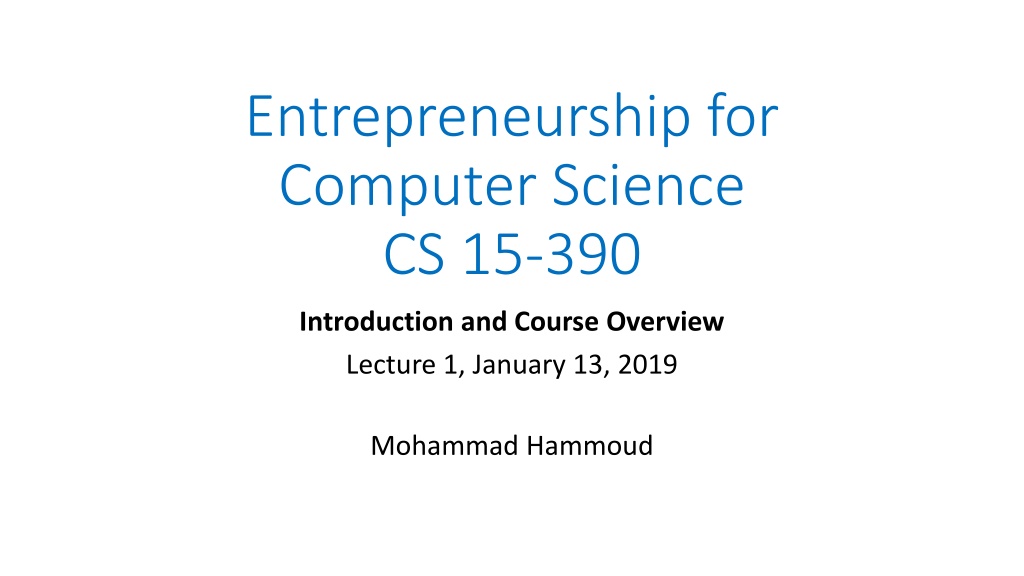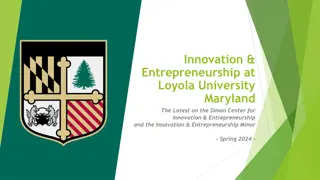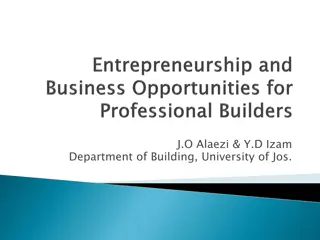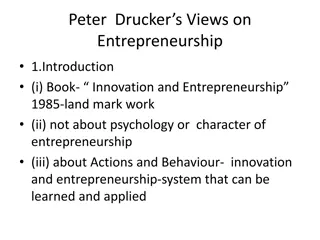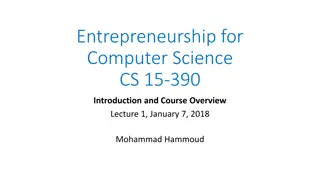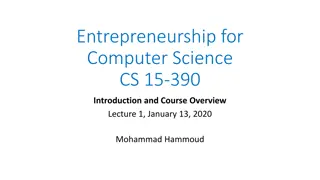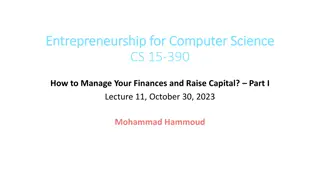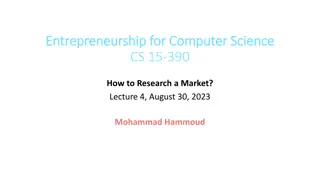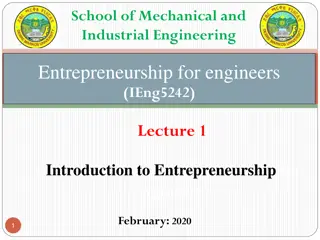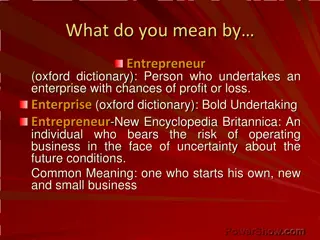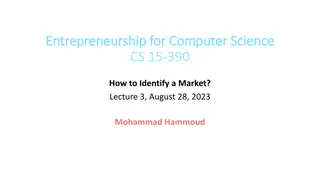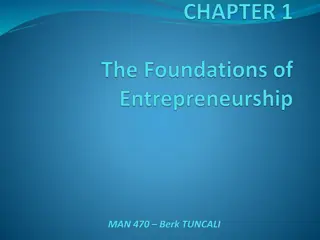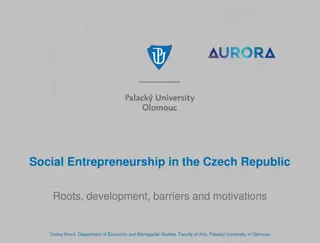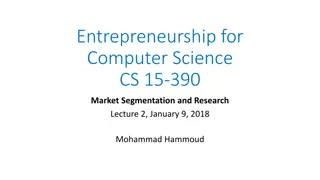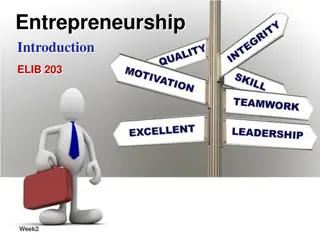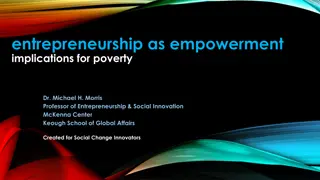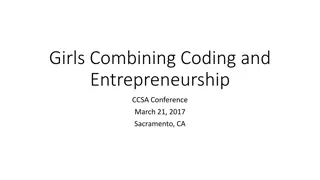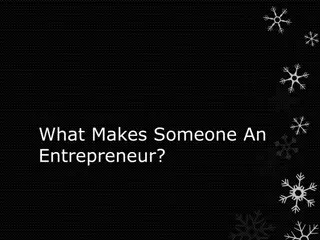Introduction to Entrepreneurship for Computer Science Course
This lecture covers the basics of entrepreneurship, defining what a startup is, the role of an entrepreneur, reasons for startup failures, and the fundamentals of building a sustainable business. It provides insights into how a startup operates under uncertainty, the importance of having paying customers, and the distinction between having a product and establishing a business. The course overview, objectives, and schedule are also outlined, emphasizing the essence of innovation and commercialization in the entrepreneurial journey.
Download Presentation

Please find below an Image/Link to download the presentation.
The content on the website is provided AS IS for your information and personal use only. It may not be sold, licensed, or shared on other websites without obtaining consent from the author.If you encounter any issues during the download, it is possible that the publisher has removed the file from their server.
You are allowed to download the files provided on this website for personal or commercial use, subject to the condition that they are used lawfully. All files are the property of their respective owners.
The content on the website is provided AS IS for your information and personal use only. It may not be sold, licensed, or shared on other websites without obtaining consent from the author.
E N D
Presentation Transcript
Entrepreneurship for Computer Science CS 15-390 Introduction and Course Overview Lecture 1, January 13, 2019 Mohammad Hammoud
Today Introduction: What is a startup? What is entrepreneurship? Who is an entrepreneur? Types of entrepreneurship Why startups usually fail? Course overview: Objectives, topics, and learning outcomes Announcements: Classes take place every Sunday and Tuesday from 4:30 to 5:50PM at room 1030 All course material can be found at: http://www.qatar.cmu.edu/~mhhammou/15390-s19/index.html
Outline Introduction Course Overview and Administrivia
Why are you Interested in Entrepreneurship? You may have an idea that can change the world or improve an existing process you are familiar with You may have a technological breakthrough and want to capitalize on it (perhaps, by founding a startup) You may have a passion and want to learn about entrepreneurship while looking for a good idea, technology, and/or a partner
Why are you Interested in Entrepreneurship? In any of these cases, at this stage you may want simply to uncover the world of startups and entrepreneurship. If so, let us get started!
What is a Startup? A startup is an organization designed to innovate a new product or service under conditions of extreme uncertainty ( The Lean Startup by Eric Ries) An organization encompasses mission, vision, strategy, culture, accounting, finance, operations, etc., In this context, however, it operates under too much uncertainty, following leap-of-faith assumptions concerning its invention Innovation = Invention commercialization This implies that having a product does not mean you have a business
The Single Condition for a Business The single necessary and sufficient condition for a business is a paying customer The day someone pays you money for your product or service, you have a business, and NOT the day before But, having a paying customer does not mean you have a sustainable business! To have a sustainable business, you need enough customers paying enough money within a reasonable amount of time
Entrepreneurship Entrepreneurship is the process of creating a sustainable business There are two types of entrepreneurship Small and Medium Enterprise (SME) Innovation-Driven Enterprise (IDE) SME SME SME SME SME SME IDE IDE IDE IDE IDE IDE Market Market Market Market Market Market Local and/or Regional Local and/or Regional Local and/or Regional Local and/or Regional Local and/or Regional Regional/Global Regional/Global Regional/Global Regional/Global Regional/Global Invention Invention Invention Invention Invention Invention Not Necessary Not Necessary Not Necessary Not Necessary Necessary Necessary Necessary Necessary Jobs Jobs Jobs Jobs Jobs Jobs Non-tradable Non-tradable Non-tradable Tradable Tradable Tradable External Capital External Capital External Capital External Capital External Capital External Capital Typically No Typically No Yes Yes Growth Growth Growth Growth Growth Growth Linear Exponential
SME and IDE Expected Revenue & Job Trends Revenue & Jobs Revenue & Jobs Burning Area Time Time : Much Riskier, but : Usually Not Risky IDE More Ambitious (Go Big or Go Home!) SME
SME and IDE Expected Revenue & Job Trends Revenue & Jobs Revenue & Jobs Burning Area The Focus of this Course! Time Time : Much Riskier, but : Usually Not Risky IDE More Ambitious (Go Big or Go Home!) SME
Entrepreneurship vs. Management IDE entrepreneurship is a special kind of management Entrepreneurship is cool, innovative, and exciting Management is dull, serious, and bland What is actually exciting is to see a startup succeed and change the world This cannot happen without managing it rightly The road to excitement passes through the (boring) management stuff! Why IDE entrepreneurship is a special kind of management?
Entrepreneurship vs. Management Why special? Traditional business thinking suggests: Perfecting a product, even if takes a great deal of time; hence, long cycle times Large teams and hierarchical organizations Failures are unacceptable Modern business (or entrepreneurial) thinking suggests: Building a minimum viable product (MVP); hence, short cycle times Focusing on what customers want, thus experimenting tremendously Failing as a prerequisite for success Small teams and flat organizations
Schools of Thought in Entrepreneurship Three major schools of thought: 1. Just Do It Most entrepreneurs are wary of implementing traditional management practices, afraid that this will invite bureaucracy or stifle creativity They assume management is the problem, hence, chaos is the answer Unfortunately, this approach leads to chaos more often than it does to success 2. Launch a Rocket Ship Specify every single step to take in excruciating details (typically by tapping into a proven set of techniques used for managing big companies) Specify the expected result of every single step taken what happens if a tiny error occurs? Can you adapt or pivot?
Schools of Thought in Entrepreneurship Three major schools of thought: 3. Plan and Improvise, but Verify Set a (hypothetical) path to reach a destination (you are not sure whether this path will lead to the destination) Experiment with and validate your path Persevere, adapt, or even pivot if needed If you are driving to work, do you give up if there is a detour in the road or you made a wrong turn? No, you remain thoroughly focused on getting to your destination The third school of though is the recommended one!
Who is an Entrepreneur? Anyone who creates a startup is an entrepreneur This implies that an entrepreneur should have a (strong) appetite of risk taking But an entrepreneur needs not create a startup; she/he can operate inside established organizations This entrepreneur is typically referred to as intrapreneur In addition, an entrepreneur does not need to invent! E.g., Steve Jobs identified the computer mouse created by Xerox PARC and commercialized it effectively through Apple E.g., Larry Page and Sergey Brin used AdWords (which was created by Overture Services, Inc) on their search results pages
The Startup Realty The grim reality is that most startups fail There are five essential elements that lead to successful startups TEAM & Execution IDEA BUSINESS MODEL FUNDING TIMING
What Makes Startups Succeed? Idea Timing Idea Timing Team B M Idea Timing Team B M Team B M Funding Funding Funding 10 10 8 10 9 8 6 8 9 10 7 7 9 5 4 Succeeded [Based on a study by IdeaLab]
What Makes Startups Succeed? Idea Timing Idea Timing Team B M Idea Timing Team B M Team B M Funding Funding Funding 8 6 4 4 5 4 6 4 4 5 6 10 5 6 10 Failed [Based on a study by IdeaLab]
What Makes Startups Succeed? Time 42% Factors of success across more than 200 companies Team & Execution 32% Idea 28% Business Model 24% Funding 14% [Based on a study by IdeaLab]
Outline Introduction Course Overview and Administrivia
Course Objectives Starting a new venture is a serious undertaking with a great deal of risk and sacrifice The objective of this course is to increase your odds of succeeding in starting, executing, and growing a company The course will provide you with a scientific and practical end-to-end framework, which will help you either succeed quickly or fail fast (if failure was inevitable for the path that you were on)
List of Topics .9. Exit Policies .8. Considered: a reasonably critical and comprehensive understanding Accounting .7. Thoughtful: fluent, flexible and efficient understanding Venture Deals .6. Finance Masterful: a powerful and illuminating understanding .5. Startup Valuation .4. Business Models and Pricing Frameworks .3. Build-Measure-Learn Feedback Loop .2. Market Segmentation and Research .1. Vision, Strategy, Team, and Culture
Learning Outcomes After finishing this course, you should be able to: 1. Form a complementary team and create an innovative culture 2. Conduct in-depth primary and secondary market research, select a beachhead market, and calculate its Total Addressable Market (TAM) size 3. Identify leap-of-faith assumptions, namely the value and growth hypotheses of a startup 4. Appreciate the build-measure-learn feedback loop as a scientific method to spiral towards testing and verifying leap-of-faith assumptions 5. Design and develop a Minimum Viable Product (MVP) to enter the build phase of the build-measure-learn feedback loop as quickly as possible
Learning Outcomes After finishing this course, you should be able to: 6. Test MVP with early adopters, collect feedback, and apply actionable analytics to steer MVP towards a Viable Product (VP) 7. Apply split-test (or A/B) experiments to evaluate different variations of a MVP or VP feature 8. Identify different engines of growth (e.g., viral and paid engines of growth) to determine product-market fit and achieve a sustainable business 9. Differentiate between various types of pivots (e.g., zoom in, zoom out, customer segment, and engine of growth pivots) 10. Design a business model, set a pricing framework, calculate the Lifetime Value (LTV) of an acquired customer, and compute the Cost of Customer Acquisition (COCA)
Learning Outcomes After finishing this course, you should be able to: 11. Value pre-revenue and post-revenue companies 12. Differentiate between different corporate metrics (e.g., price-to-earnings ratio and return-on-assets), stock types, bonds, equity, and debt 13. Understand the venture capital financing process and raise money for a startup the right way 14. Apply accrual accounting and interpret the three core financial statements, namely, the balance sheet, income statement, and cash flow statement 15. Recognize different exit policies (e.g., Initial Public Offering)
Assessment Methods How learning will be measured? Type # Weight Project 1 35% Exams 2 35% Problem Sets 6 15% Quizzes 2 10% In-class Participation and Attendance 40 5%
Target Audience, Prerequisites, and Textbooks Target audience: all CMU-Q students Prerequisites: Nothing, except being a CMU-Q student No specific textbook, but here are some references: Disciplined Entrepreneurship by Bill Aulet The Founder s Dilemmas by Noam Wasserman Zero to One by Peter Thiel The Lean Startup by Eric Ries How Google Works by Eric Schmidt and Jonathan Rosenberg Work Rules!: Insights from Inside Google That Will Transform How You Live and Lead by Laszlo Bock
Next Class Forming teams and generating ideas Performing market segmentation and research (Part I)
